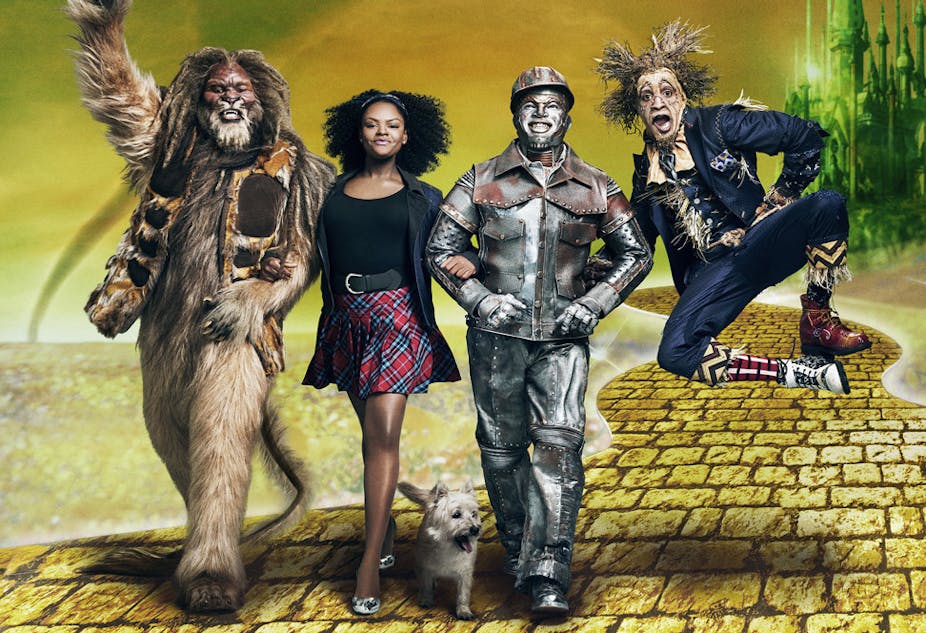For two hours on a Saturday night in 1955, TV viewers in Harlem turned off their television sets, a boycott meant to send a message to the nation’s broadcasting networks.
The reason? According to NAACP Vice President Odell Clarke (quoted in a February 21 1955 St Petersburg Times article), blacks had been “almost totally excluded from employment in the radio and television industry.”
Sixty years later, Clarke, along with the thousands in Harlem who tuned out that night in February, would have likely seen a small victory in The Wiz Live!
The primetime television special – an R&B reinterpretation of The Wizard of Oz that aired on NBC last Thursday evening – featured an all-black cast.
In a TV landscape dominated by white actors, The Wiz Live! was a welcome sight for many watching. Audiences also observed a difference during commercial breaks: an increase in the number of advertisements targeting black viewers.
One viewer wondered if she were the only one noticing “the abundance of black people placed in these commercials.”
According to the reaction on social media, she wasn’t. A Rutgers professor confessed that the commercials – which featured black actors, along with black celebrities like Brandy, Stevie Wonder, Mary J Blige, Kerry Washington and D L Hughley – were “giving her life.” It’s “all Black everythang,” she happily concluded.
Meanwhile, another viewer “loved all the demo-specific ads,” while a Texas mom noted, “All ethnic programming and ads get play tonight.”
Finally, a recent college grad tweeted, “I’ve actually never seen so many black ads in my life.”
If so many people noticed the commercials, there must have been a significant spike in ads targeting black consumers, right? So how many did The Wiz Live! feature?
Well, let’s count: over the course of The Wiz Live!‘s 165 minutes, approximately 127 commercials aired. During each of the 13 commercial breaks, we saw an average of 10 ads. Fewer than 10 (of the 127) ads were local. (For me, in Chicago, the local ads promoted news, businesses and theater.)
Some of the companies that featured all-black casts and/or recognized a black cultural experience were BET, AARP, Toyota, NBC for The Carmichael Show, Apple Music, Walmart, Value City Furniture and McDonald’s (this ad, featuring Tom Joyner and D L Hughley, ran three times during the live event).
One might also argue that Reddi-Whip reached out to black viewers with its commercial and that NBC’s ads for its upcoming series Telenovela, featuring Eva Longoria as the star of a Spanish soap opera, were aimed at people of color.
So, yes, the numbers seem promising.
But actually, of the 120 commercials (local ones excluded), only 13 targeted black audiences by my count – which amounts to roughly 10%.
What does this mean? First, American TV viewers are so accustomed to seeing white people selling products that when they see a shift – even if it’s a small one – it’s (shamefully) pronounced. Such a variation, I imagine, is what prompted one viewer to comment during The Wiz Live!, “What if there were this many black ads all the time? What if seeing black folk was normalized?”
Second, if The Wiz Live! were an event popular with African-American audiences – and, according to Nielsen, it was – the percentage of ads targeting blacks apparently hasn’t budged much in the last few years.
For example, a 2009 content analysis of ads that aired during the 10 highest-rated network primetime programs watched by African Americans found that only 8.5% featured all-black casts. During these same shows, 46.2% showcased all-white casts, with racially integrated casts making up the other 45.3%.
The New Yorker’s Emily Nussbaum recently wrote about P Jay Sidney, a largely forgotten African-American actor who spent his entire career lamenting the underrepresentation of blacks in the television industry. Nussbaum quotes a 1954 column penned by Sidney, which appeared in the Amsterdam News:
…by not including Negroes in at least approximately the numbers and the roles in which they occur in American life, television and radio programs that purport to give a true picture of American life malign and misrepresent Negro citizens as a whole.
Today, could we say that a true picture of American life is broadcast into our living rooms? Shows like The Wiz Live! certainly help change the status quo. But the entertainment and marketing industries have a long way to go.

